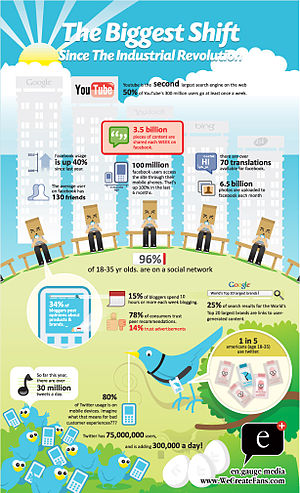
Marketing is an ever-changing landscape, which we’ve seen with the rise and fall of SEO and the revolution of Inbound Marketing led by the guys over at HubSpot. Social Media has also become one of the big influencers in marketing, becoming an integral part in any successful business marketing strategy.
Here are some ways that Social Media has helped to reshape marketing.
Facebook and Twitter’s new influence on Search
With how ‘likes’ and ‘shares’ plus ‘retweets’ are becoming more and more important in getting the word out, the big search engines have started to realize that those public announcements are like a vote of confidence from the sharer. Permanent links were what all SEOs had dreamed about. Now, SEOs are hoping to get their links shared by influential tweeters, which are proving to influence search ranking factors. Here’s an unexpected case study on a tweet’s effect on rankings by SEOmoz Of course, there is more value than just the boost in search rankings from ‘likes’ and tweets. There is brand exposure and clicks, which also are valuable things in marketing. But there is no doubt that with the search industry continuing to grow, that Social Media should be an important part of any SEO strategy, what with the growing influence Social Media has on search rankings.
Companies Focus on Engagement versus Selling
Think about how back in the day we used to have our local dry cleaner who everyone in the family knew and who knew everyone in the family, the convenience store clerk who you talked to about your problems at work while he made your favorite cup of coffee, and the homely waitress at the local diner who knew how to get your eggs just right. Those were the days that were less about profit and transactions and were more about creating genuine, personal relationships. Businesses now, through Social Media, are working to reverse the effects time has had on the personal customer experience by engaging users to create more loyalty. It’s not unusual to get an @reply from a company saying thanks for sharing a neat tweet or even engaging in an intellectual or simply fun exchange with you.
Blogging to Build Influence and Authority
I was recently approached by the awesome Noah Kagan who asked about leveraging blogging to build influence and authority after seeing my name pop up in some of the bigger outlets in the startup space. An authority in the marketing realm himself, I was more than happy to oblige because I had much respect for the former Director of Marketing at Mint.com and current Chief Sumo at App Sumo. Wise professionals and marketers like him are continuing to understand the value in blogging. Both in the networking value because you become part of the writing community where other writers treat you as a peer, and in the authority you build, becoming an expert and influencer in the space you write about. I also had a recent chat with Scott Gerber, expert on young entrepreneurship, who is syndicated in outlets like Entrepreneur, WSJ, FoxNews and more. By blogging, he became one of the leading sources in everything about young entrepreneurship, and is constantly receiving inbound inquiries (perhaps more than he can handle) about what’s new in youth entrepreneurship.
Social Media as a New Distribution Channel
By using channels like Twitter, Facebook and YouTube, you leverage your network, your second- and third-degree networks and heavily trafficked platforms for mass distribution because of the viral potential these channels have. Here’s an interesting study by ChompOn showing the value of social action in online commerce. These days, it’s less about the stale press release, which is arguably dead, and more about empowering customer evangelists, who are more trusted referral sources in spreading the word. In fact, some businesses leverage Social Media to create hype or make announcements about exciting things they’re doing. The popular Robert Scoble played an integral role in helping to launch the awesome Flipboard app, which couldn’t support all the great hype it got during launch, but was able to rebound.
Social Media Advertising
It’s amazing what’s happening in marketing these days, especially in advertising, which supposedly became a dying channel once other cost-effective channels like SEO and Social Media started popping up. But one new form of advertising emerged from all this change, Social Media advertising. For example, you can do Youtube video and channel sponsorship. Some of these YouTube vloggers even have agents, just the same way famous movie stars and athletes do! But with sponsorship of a Youtube vlogger, you can promote your business and product to that special vlogger’s community of thousands of subscribers that might even reach millions of viewers. A killer success story here is with custom women’s shoes startup, Shoes of Prey, sponsoring a 16 year old video blogger to create a video promoting their product which led to 500,000 views in one week and a permanent tripling of sales, absolutely nothing short of most marketers’ dreams. Then, there’s also sponsored blog posts, which are noted as such, on blogs with massive followings to get links and traffic, plus a permanent post to be used as reference when Googlers search it, or when readers are looking for something related to your business on that blog. There are even endorsed tweets, with networks like Ad.ly where you can pay to get a celebrity to endorse you through Social Media. Other networks even let you sponsor the average layman to tweet your link letting their followers know they support you.
Active Listening to Incorporate Customers into the Feedback Loop
The age of Social Media came with the age of active listening. Consumers now had a voice, and businesses were now lending an ear because businesses that didn’t faced a ton of flak from those now empowered and vocal consumers. But with all this active listening came active responses, allowing companies to figure out better ways to serve and target their audience after learning more about their core consumer’s desires and needs. Active listening and responding to your community keeps businesses lean since they’re getting feedback and iterating based on that feedback, which is more than just analytics and data alone.
How else has Social Media impacted marketing?
Get the TNW newsletter
Get the most important tech news in your inbox each week.





